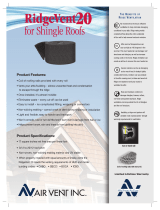Page is loading ...

SHINGLEVENT
®
II
Installation Instructions
ROOF PITCH:
PRODUCT FEATURES: CUSTOMER SERVICE:
BEFORE YOU INSTALL -
Install only one type of exhaust vent, remove or plug any existing vents (gable vents, roof louvers, wind turbines and power
fans). Install adequate Intake Ventilation for a Balanced System (50% Exhaust & 50% Intake) in accordance with state and local code requirements. Intake vents must
be installed low at the roof’s edge or in the soffit/undereave. Products such as Air Vent’s Continuous Soffit Vent, Vented Drip Edge, Undereave Vents and The Edge™
Vent provide the necessary intake ventilation for optimum performance.
FIGURE 1. RIDGE BOARD TYPE CONSTRUCTION FIGURE 2. STEEP PITCH ROOF (16/12)
FIGURE 3. TRUSS TYPE CONSTRUCTION
See below for special conditions of steep pitch roofs and truss type construction.
TOOLS REQUIRED:
ShingleVent
®
II fits roofs with 3/12 to 16/12 pitches.
ShingleVent
®
II-7 and ShingleVent
®
II-9 fit roofs with 3/12 to 12/12
• Hammer
• Utility knife
• Chalk line
If you have any questions or require special
installation assistance, call our toll-free number
8 a.m. - 5 p.m. (C.S.T.) Monday - Friday
1-800-AIR-VENT (247-8368)
• Roofing nails
• Tape measure
• Circular saw
RIDGE BOARD
RIDGE VENT
13-1/8” (SV II)
10-3/4” (SV II-9)
9-1/2” (SV II-7)
CAP SHINGLES
AIR SLOTS
DRAIN SLOTS
RAFTER
RAFTER
3/4”
1”
1-1/2”
3/4”
3”
6
12
FELT
Return roofing felt for new roof construction
or use continuous sealant bead for existing
roof construction
Cut out slot for existing roof
construction, leave gap for
new roof construction
Do not let cap
shingle overhang
edge of air slot
ROOFING
NAILS
FILTER
CAUTION: on steep pitch
roof conditions verify proper
clearance from edge of
sheathing prior to nailing
3/4” 3/4”
3”
TRUSS TRUSS
1-1/2”
Internal Weather Filter
Imprinted Slot Guides
Preformed Nail Bosses
Air Slots*
Reinforced Ribs
High Gloss Nailing Lines
*18 sq. inches (ShingleVent
®
II) or 16 sq. inches (ShingleVent
®
II-7
and ShingleVent
®
II-9) free vent area per linear foot.
Built-in Ventilating End Plug
External Wind Baffle
Cap Shingles
Highest Quality Co-Polymer

SHINGLEVENT
®
II
IMPORTANT NOTES BEFORE INSTALLING
When using architectural shingles, seal the gap between the vent and shingles making sure not to plug drain holes. 1.
Caulk is not needed with 3-tab shingles.
Make sure the filter (if supplied) is centered in the ridge vent and pinched to the shingles prior to cap nailing, leaving no gaps.2.
When installing the ridge vent in cold weather, leave a 1/8” gap between ridge vent ends to allow for expansion in hot weather.3.
See instructions below for cutting slot.4.
Run the ridge vent from end to end on the roof for a more even, attractive appearance.5.
Carefully place the ridge vent prior to cap shingle nailing with the preformed nail holes provided in the vent. Overnailing will 6.
cause the vent to buckle. Undernailing could allow the nails to back out of the deck.
All nails must penetrate the underside of the roof deck. Verify adequate nail length prior to installation.7.
STEP 1.
STEP 4.
STEP 2.
STEP 5.
STEP 3.
STEP 6.
1. On existing roofs, remove cap shingles. Mark
slot width at both ends of ridge. Use slot guides
imprinted on vent and refer to drawings below.
Snap chalk line on both sides of ridge.
4. Pre-fasten first section using roofing nails
through preformed nail bosses. Continue to
pre-fasten remaining sections, making sure
support ribs are flat on the roof and filter is
secure between shingles and vent.
Hip and Gable Roofs
Cut slot 3/4” on both sides of ridge centerline
or from ridge board and to within 6” of end
wall or hip intersection as illustrated in
Figure 4.
2. Cut slot (plumb cut, if possible). Note: Adjust
depth of blade to avoid cutting rafters or trusses.
Refer to drawings below for slot dimensions.
Remove debris from slot.
5. Use utility knife to cut final section to length.
Final section should be oriented so that the built-in
ventilating end plug is flush with the end of the
roof. Pre-fasten final section.
“L” and “T” Shaped Roofs
Cut slot as per Figure 5 and run Ridge Vent
across long ridge. On short ridge, cut slot to within
12” of junction point and run Ridge Vent from
end of roof to butt against crossing Ridge Vent.
3. Center vent over slot. End should be flush
with end of roof. Make sure vent’s support ribs
sit flat on the roof, and that filter is secure
between shingles and vent.
6. Nail cap shingles in place using roofing
nails long enough to penetrate roof sheathing.
Use nailing lines provided on vent as guide.
If using a nail gun, refer to #6 & 7 under
important notes.
Chimneys
Cut slots to within 12” of chimney. Run
Ridge Vent from end of roof to butt
against chimney as shown in Figure 6.
INSTRUCTION FOR CUTTING SLOTS
indicates slot width indicates vent run indicates end wall
6" from
end wall
to slot
6" from
end wall
to slot
6" from
end wall
to slot
6"
12"
12"
12"
slot width
End wall
End wall
End wall
End wall
Fig. 6
Run Ridge Vent
to end of ridge
Hip end
Fig. 4 Gable end Fig. 5
Run Ridge Vent to
end of ridge
End wall
End wall
6" from
end wall
to slot
6" from
end wall
to slot
For warranty information refer to enclosed document or visit www.airvent.com
NOTE: Air Vent’s written warranty for this product will be invalid in any instance in which the product was not property installed in accordance with the instructions.
4117 Pinnacle Point Drive, Suite 400 Dallas, TX 75211
www.airvent.com • [email protected]
1-800-AIR-VENT (247-8368)
Part #717362
©2013 Air Vent, Inc.
Rev. 03/2013
/








